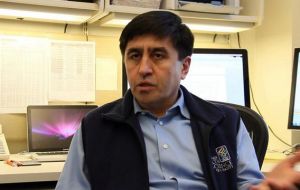MercoPress. South Atlantic News Agency
US scientists with cloning techniques created human embryonic stem cells
 Shoukhrat Mitalipov, lead researcher on the project at OHSU
Shoukhrat Mitalipov, lead researcher on the project at OHSU For the first time, Oregon State researchers in the US have used cloning techniques to create human embryonic stem cells that could offer hope for conditions such as Parkinson's disease, diabetes and multiple sclerosis.
The landmark discovery by an Oregon Health & Science University team involved taking a skin cell from an 8-month-old child with a rare inherited disease and replacing the nucleus of a donated human egg cell with it.
Stem cells have been a research focus for more than a decade because they can morph into any type of cell, potentially leading to treatments to replace damaged cells and organs. But along with the promise of the technology has come ethical questions and worry over human clones.
Until now, the best human stem cells were made using a different method and have not been truly identical. The new method could prove more valuable for treatment, said Natalie DeWitt, a cell and molecular biologist for the California Institute for Regenerative Medicine. “It's a big deal,” she said.
A similar process was used to clone a well-publicized sheep, named Dolly, in 1996. But while the process had been done in animals, many scientists had concluded it was impossible to replicate in humans.
“It's been really challenging: many people have tried,” DeWitt said. “From a technical point of view it shows how good this group really is.”
Shoukhrat Mitalipov, the lead researcher on the project and an OHSU biologist who maintains a lab at the Oregon National Primate Research Center, says the method cannot create embryos viable for human reproduction. Repeated efforts to clone primates with the method have been unsuccessful, he said.
Putting the discovery to work in medical therapies could be a decade away, he said. “There's still a huge amount of work to be done.”
The Oregon achievement has already prompted calls for new laws to prevent human reproductive cloning, for ethical reasons.
“If we're going to be having cloned embryos in laboratories around the country, we really need to get our act together and have a law that prohibits human reproductive cloning,” said Marcy Darnovsky of the Califor
nia-based Center for Genetics and Society. “Sixty countries have done that.”
DeWitt said it's possible that someone could try to implant embryos created using the OHSU technique into a mother's uterus. But without further advances, those embryos would be unlikely to survive. Also, it would be hard to reach the level of sophistication achieved by Mitalipov, and for ethical reasons most doctors would not try, she said.
The testing was done in a special lab set up by OHSU apart from its normal federally funded lab, due to government restrictions on stem cell research and destruction of human embryos. The OHSU Foundation and the LeDucq Foundation of France funded the work




Top Comments
Disclaimer & comment rules-

-

-

Read all comments“us-scientists-with-cloning-techniques-created-human-embryonic-stem-cells”
May 16th, 2013 - 06:25 am 0Earlier experiments went horribly wrong, resulting in Stevie/Guzz and Think/Dover.
Many “ethical problems” with such clones.
Troy,
May 16th, 2013 - 08:45 am 0No, you're getting confused with Dr Frankenstein.
Unfortunately Troy, they let their experiments escape.
May 16th, 2013 - 10:25 am 0Commenting for this story is now closed.
If you have a Facebook account, become a fan and comment on our Facebook Page!